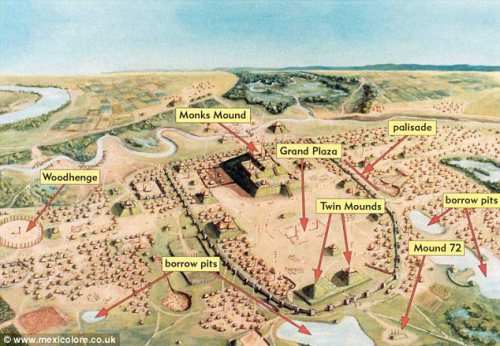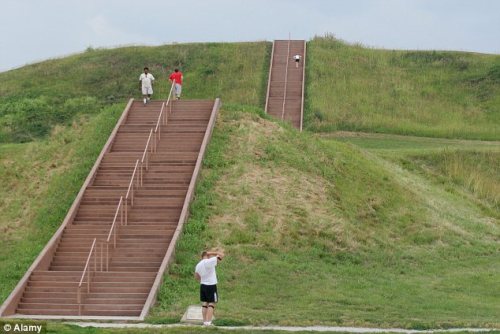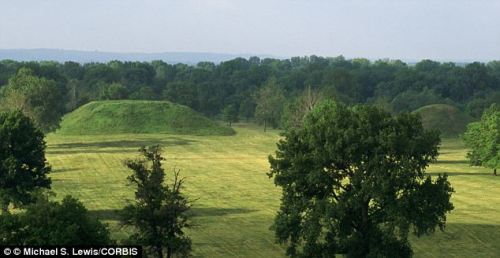January 2013
The Lost City Of Cahokia : Archaelogists Uncover Native Americans Sprawling Metropolis Under St. Louis –
Posted on January 26, 2013 by lucas2012infos | Leave a comment
 A sprawling Native American metropolis which lay hidden beneath a modern city for a millennium has been uncovered.
A sprawling Native American metropolis which lay hidden beneath a modern city for a millennium has been uncovered.
An aerial view of Monks Mound with tiny cars visible in the background reveals the site’s scope.
Archaeologists digging in preparation for the Mississippi River
spanning bridge – which will connect Missouri and Illinois – discovered
the lost city of Cahokia beneath modern St Louis.
Their findings pointed to a ‘sophisticated, sprawling metropolis
stretching across both sides of the Mississippi’, Andrew Lawler told the
journal Science.
An artist impression of what the ancient Native American city of
Cahokia, which was discovered beneath modern St Louis, would have looked
like :

Cahokia, which is near Collinsville in Illinois, was initially
believed to be just a ‘seasonal encampment’. But experts now think it
was a location of much more significance.
Mr Lawler wrote: ‘A millennium ago, this strategic spot along the
Mississippi River was an affluent neighbourhood of Native Americans, set
amid the largest concentration of people and monumental architecture
north of what is now Mexico.
The 100ft Monks Mound is in the centre of the Cahokia Mounds State Historic Site :

‘Back then, hundreds of well-thatched rectangular houses, carefully
aligned along the cardinal directions, stood here, overshadowed by
dozens of enormous earthen mounds flanked by large ceremonial plazas.
‘Cahokia proper was the only pre-Columbian city north of the Rio
Grande, and it was large even by European and Mesoamerican standards of
the day, drawing immigrants from hundreds of kilometres around to live,
work, and participate in mass ceremonies.’
Archaeologists found in the latest series of excavations evidence of more than 500 thatched houses:

The latest excavations uncovered evidence of more than 500 thatched
houses. At its peak the city would have been home to 100,000 Native
Americans.
But Cahokia lacked the density of Mayan or European settlements –
instead appearing to have organised itself along the lines of ‘modern
American urban sprawl’.
The remains of the ancient city can be seen at the 2,000 acre Cahokia
Mounds State Historic Site, which lies just across the Mississippi
River from St Louis.
The city, the most sophisticated Native civilisation north of Mexico,
was inhabited from 700AD to 1400 and known for its large, man-made
earthen structures.
Its original population was thought to have been in the hundreds, but in the 11th century swelled to tens of thousands.
An Indian civilization inhabited the Illinois area from 900 to 1500 AD :

The Cahokian population is thought to have started to fall after the
year 1200, and two centuries later the entire site had been abandoned.
Theories vary as to why it was vacated, including climate changes, war,
disease, and drought.
The site is still thought to be sacred and Native Americans believe
it is a source of powerful psychic energy. The Cahokia Mounds State
Historic Site was designated a National Historic Landmark in 1964 and as
a World Heritage Site in 1982.
Thanks to: http://lucas2012infos.wordpress.com
The Lost City Of Cahokia : Archaelogists Uncover Native Americans Sprawling Metropolis Under St. Louis –
Posted on January 26, 2013 by lucas2012infos | Leave a comment
 A sprawling Native American metropolis which lay hidden beneath a modern city for a millennium has been uncovered.
A sprawling Native American metropolis which lay hidden beneath a modern city for a millennium has been uncovered.An aerial view of Monks Mound with tiny cars visible in the background reveals the site’s scope.
Archaeologists digging in preparation for the Mississippi River
spanning bridge – which will connect Missouri and Illinois – discovered
the lost city of Cahokia beneath modern St Louis.
Their findings pointed to a ‘sophisticated, sprawling metropolis
stretching across both sides of the Mississippi’, Andrew Lawler told the
journal Science.
An artist impression of what the ancient Native American city of
Cahokia, which was discovered beneath modern St Louis, would have looked
like :

Cahokia, which is near Collinsville in Illinois, was initially
believed to be just a ‘seasonal encampment’. But experts now think it
was a location of much more significance.
Mr Lawler wrote: ‘A millennium ago, this strategic spot along the
Mississippi River was an affluent neighbourhood of Native Americans, set
amid the largest concentration of people and monumental architecture
north of what is now Mexico.
The 100ft Monks Mound is in the centre of the Cahokia Mounds State Historic Site :

‘Back then, hundreds of well-thatched rectangular houses, carefully
aligned along the cardinal directions, stood here, overshadowed by
dozens of enormous earthen mounds flanked by large ceremonial plazas.
‘Cahokia proper was the only pre-Columbian city north of the Rio
Grande, and it was large even by European and Mesoamerican standards of
the day, drawing immigrants from hundreds of kilometres around to live,
work, and participate in mass ceremonies.’
Archaeologists found in the latest series of excavations evidence of more than 500 thatched houses:

The latest excavations uncovered evidence of more than 500 thatched
houses. At its peak the city would have been home to 100,000 Native
Americans.
But Cahokia lacked the density of Mayan or European settlements –
instead appearing to have organised itself along the lines of ‘modern
American urban sprawl’.
The remains of the ancient city can be seen at the 2,000 acre Cahokia
Mounds State Historic Site, which lies just across the Mississippi
River from St Louis.
The city, the most sophisticated Native civilisation north of Mexico,
was inhabited from 700AD to 1400 and known for its large, man-made
earthen structures.
Its original population was thought to have been in the hundreds, but in the 11th century swelled to tens of thousands.
An Indian civilization inhabited the Illinois area from 900 to 1500 AD :

The Cahokian population is thought to have started to fall after the
year 1200, and two centuries later the entire site had been abandoned.
Theories vary as to why it was vacated, including climate changes, war,
disease, and drought.
The site is still thought to be sacred and Native Americans believe
it is a source of powerful psychic energy. The Cahokia Mounds State
Historic Site was designated a National Historic Landmark in 1964 and as
a World Heritage Site in 1982.
Thanks to: http://lucas2012infos.wordpress.com






 Sat Mar 23, 2024 11:33 pm by globalturbo
Sat Mar 23, 2024 11:33 pm by globalturbo

